LESSON PLAN
Theme “Magnetic flux. The phenomenon of electromagnetic induction, grade 9
Lesson Objectives:
The goal is to achieve educational outcomes.
Personal results:
– development of cognitive interests, intellectual and creative abilities;
– independence in acquiring new knowledge and practical skills;
– formation of value attitudes towards learning outcomes.
Metasubject results:
- mastering the skills of independent acquisition of new knowledge, organization of educational activities, setting goals, planning;
- mastering the methods of action in non-standard situations, mastering heuristic methods for solving problems;
- the formation of skills to observe, to highlight the main thing, to explain what is seen.
Subject Results:
– know: magnetic flux, induction current, electromagnetic induction phenomenon;
– understand: the concept of flow, the phenomenon of electromagnetic induction
– be able to: determine the direction of the induction current, solve typical problems of the OGE.
Lesson type: learning new material
Lesson form: study lesson
Technology: elements of critical thinking technology, problem-based learning, ICT, problematic dialogue technology
Lesson equipment: computer, interactive whiteboard, coil, tripod with foot, bar magnet - 2 pcs., demonstration galvanometer, wires, device for demonstrating Lenz's rule.
During the classes
Start: 10.30
1. Organizational stage (5 minutes).
Hello guys! Today I will conduct a physics lesson, my name is Innokenty Innokentevich Malgarov, a physics teacher at the Kyllakh school. I am very glad to work with you, with high school students, I hope today's lesson will be productive. At today's lesson attentiveness, independence, resourcefulness are estimated. The motto of our lesson with you is “Everything is very simple, you just need to understand!”. Now, the roommates look at each other, wish good luck and shake hands. For feedback, I will sometimes clap my hands, and you will repeat. Let's check? Amazing!

Please look at the screen. What do we see? That's right, a waterfall and a strong wind. What word (one!) combines these two natural phenomena? Yes, flow. Water flow and air flow. Today we will also talk about flow. Only about a stream of a completely different nature. Can you guess what? What are the topics that you have previously covered? That's right, magnetism. Therefore, write down the topic of the lesson in your worksheets: Magnetic Flux. The phenomenon of electromagnetic induction.
Start: 10.35
2. Actualization of knowledge (5 minutes).
Exercise 1. Please look at the screen. What can you say about this picture? Fill in the blanks on the worksheets. Consult with a partner.

1. Around the conductor with current arises a magnetic field. It is always closed;
2. The force characteristic of the magnetic field is magnetic induction vector 0 "style="border-collapse:collapse;border:none">
Look at the screen. By analogy, fill in the second column for the contour in a magnetic field.
Look at the demonstration table, please. On the table you see a rack with a movable rocker with two aluminum rings. One whole, and the other - with a slot. We know that aluminum does not exhibit magnetic properties. We begin to introduce the magnet into the ring with a slot. Nothing happens. Now let's start introducing the magnet into the whole ring. Pay attention, one hundred ring begins to "run away" from the magnet. We stop the movement of the magnet. The ring also stops. Then we begin to carefully remove the magnet. Now the ring starts to follow the magnet.
Try to explain what you see (students try to explain).
Please look at the screen. There is a hint hidden here. (Students come to the conclusion that by changing the magnetic flux, you can get an electric current).
Task 4. It turns out that if you change the magnetic flux, you can get an electric current in the circuit. You already know how to change the flow. How? That's right, you can strengthen or weaken the magnetic field, change the area of the contour itself and change the direction of the contour plane. Now I will tell one story. You listen carefully and do task 4 in parallel.
In 1821, the English physicist Michael Faraday, inspired by the work of Oersted (the scientist who discovered the magnetic field around a conductor with current), set himself the task of obtaining electricity from magnetism. For almost ten years he carried wires and magnets in his trouser pocket, unsuccessfully trying to get an electric current out of them. And one day, quite by accident, on August 28, 1831, he succeeded. (Prepare and show a demonstration). Faraday found that if the coil is quickly put on (or removed from) a magnet, then a short-term current arises in it, which can be detected using a galvanometer. This phenomenon has been called electromagnetic induction.
This current is called by induction current. We said that any electric current generates a magnetic field. The induced current also creates its own magnetic field. Moreover, this field interacts with the field of a permanent magnet.
Now, using the interactive whiteboard, determine the direction of the induction current. What conclusion can be drawn regarding the direction of the magnetic field of the induction current?
Start: 11.00
5. Application of knowledge in various situations (10 minutes).
I suggest you solve the tasks that are offered in the OGE in physics.

Task 5. A strip magnet is brought to a solid aluminum ring suspended on a silk thread at a constant speed (see figure). What will happen to the ring at this time?
1) the ring will remain at rest
2) the ring will be attracted to the magnet
3) the ring will be repelled by the magnet
4) the ring will begin to rotate around the thread
Task 6.
 1) Only in 2.
1) Only in 2.
2) Only in 1.
4) Only in 3.
Start: 11.10
5. Reflection (5 minutes).
It's time to evaluate the results of our lesson. What have you learned? Were the goals that were set at the beginning of the lesson achieved? What was difficult for you? What did you especially like? What feelings did you experience?
6. Information about homework
Find in your textbooks the topic “Magnetic flux”, “The phenomenon of electromagnetic induction”, read and see if you can answer the questions for self-examination.
Thanks again for your cooperation, for your interest and, in general, for a very interesting lesson. I wish you to study physics well and, on its basis, to learn the structure of the world.
“It’s very simple, you just need to understand!”
Surname, name of the student _______________________________________ 9th grade student
Date "____" ________________2016
WORKSHEET
Lesson topic: _________________________________________________________________
__________________________________________________________________________
644 " style="width:483.25pt;border-collapse:collapse;border:none">
Task 4. Fill the gaps.
1. The phenomenon of the occurrence of current in a closed conductor (circuit) when the magnetic field penetrating this circuit changes is called _______________________;
2. The current that occurs in this circuit is called _____________________;
3. The magnetic field of the circuit created by the induction current will be directed to __________________ of the magnetic field of the permanent magnet (Lenz's Rule).
http://pandia.ru/text/80/300/images/image006_55.jpg" align="left hspace=12" width="238" height="89"> Task 6. There are three identical metal rings. A magnet is removed from the first ring, a magnet is inserted into the second ring, and a fixed magnet is located in the third ring. In which ring does the induced current flow?
1) Only in 2.
2) Only in 1.
